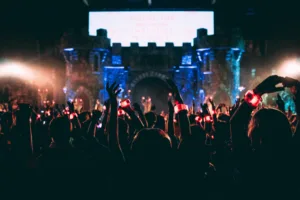Step into the world of music festivals – a realm where neon lights dance across the sky, beats drop, and memories are made. In this oasis of freedom and fun, there’s a new trend catching on, and it’s not just about the latest fashion or the hottest DJ. It’s about being informed, especially when it comes to something as critical as recognizing opioid overdose symptoms.
Knowing the signs of an opioid overdose is becoming as essential as knowing the lineup of your favorite acts. It’s the kind of knowledge that empowers you, makes you a more responsible festival-goer, and frankly, it’s pretty cool to be the person who’s equipped to help in an emergency. It’s about combining the carefree spirit of festivals with a dose of awareness that can literally save a life.
So, let’s dive into the signs of an opioid overdose – not to dampen the party spirit, but to elevate it. By understanding what to look out for, you become part of a community that looks out for each other, ensuring that the only thing that overwhelms you at a festival is the music and the good vibes.
Spotting the Signs: Opioid Overdose 101
When it comes to recognizing an opioid overdose, it’s all about knowing the key signs – and trust me, it’s simpler than figuring out the festival map. Here’s your quick guide to Opioid Overdose 101, served up with a side of easy-to-remember pointers.
- Unusual Sleepiness or Unresponsiveness: If you see someone who seems more than just tired or drunk – like they’re unusually drowsy or can’t be woken up – that’s a red flag. Picture someone snoozing through the headliner’s earth-shaking set; it’s that level of unresponsiveness we’re talking about.
- Slow, Shallow Breathing or No Breathing at All: Keep an ear out for breathing that sounds more like snoring or gasping. Sometimes, it might be so faint or non-existent that you’ll need to watch their chest for movement.
- Blue or Grayish Skin Tones, Particularly Lips and Fingernails: This one’s a bit like checking if your festival wear is color-coordinated, but way more important. If someone’s skin, lips, or nails are turning a shade of Smurf, that’s a serious SOS.
- Pinpoint Pupils: Think about those tiny, focused pupils you get in a photo taken with a flash – if someone’s pupils are looking like that in the middle of a bright day, it’s time to act.
Remember, distinguishing an opioid overdose from a hangover or heat exhaustion is key. If someone’s just a bit dehydrated or danced too hard, they’ll probably still respond to you and won’t have those telltale blueish tones or tiny pupils.
Armed with this knowledge, you’re not just another face in the crowd – you’re a festival superhero in disguise, ready to spot trouble and keep the good times rolling safely.
What to Do After Recognizing the Signs of Opioid Overdose
So, you’ve spotted the signs – someone might be experiencing an opioid overdose. What’s next? It’s hero time, and here’s how you can step up:
- Call for Medical Help Immediately: This is always the first step. Time is crucial in an overdose situation, so get the professionals on the scene as fast as you can. Use the festival’s emergency contact if available, or dial the local emergency number.
- Use Narcan if Available: If you have access to Narcan (naloxone) and know how to use it, now’s the time. This life-saving medication can reverse the effects of an opioid overdose, and it’s become a festival essential. Don’t worry; it’s safe and easy to use, and it won’t harm someone if opioids aren’t the cause of their symptoms.
- Keep Them Safe and Comfortable: While waiting for medical help, keep the person safe. If they’re breathing, place them in the recovery position to keep their airway clear. If they’re not breathing, and you’re trained in CPR, start it immediately.
- Stay With Them: Your presence can make a huge difference. Stay with the person until help arrives, offering reassurance and support. Sometimes, just knowing someone is there for them in a moment of vulnerability can be incredibly comforting.
Remember, recognizing and responding to an opioid overdose doesn’t just make you a responsible festival-goer; it makes you a lifesaver. It’s about taking that spirit of unity and community that festivals are all about and putting it into action. By being prepared to step in and help, you’re not just ensuring the party goes on – you’re making sure everyone gets to enjoy it safely.
In conclusion, being aware of opioid overdose symptoms and knowing how to respond is a crucial skill for every festival-goer. It’s about adding a layer of care and responsibility to the fun and freedom of festivals. So, let’s keep the music playing, the good times rolling, and our festival family safe.







